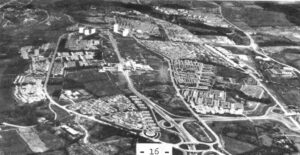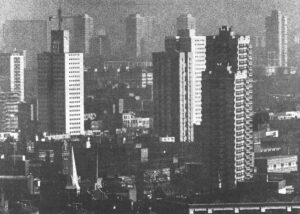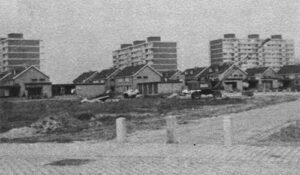Leonard Downie
- 1971

Fellowship Title:
- Urban Development in the U.S. and Europe
Fellowship Year:
- 1971

The Disappointing New Towns of Great Britain
Straddling a divided four-lane highway on a windy hilltop northeast of Glasgow is a chaotic architectural montage of interconnected buildings and passages of various sizes, shapes and colors that has become internationally famous: the all-in-one city center of the new town of Cumbernauld. The irregular mass of stores, offices, apartments, a hotel and a church seems to be constantly in motion; as you approach, it takes on a different shape with every change in angle. It was meant to be the pulsating heart of Cumbernauld. But as one nears the Cumbernauld center, its architecturally kinetic appearance gives way to the strange stillness of its empty approach roads and deserted pedestrian corridors, broken only by the rustle of wind-blown trash and the occasional shouts of marauding bands of children. Although the early evening sunshine is still bright, no stores or other facilities are open, except the hotel’s bar and dining room. Although the center is only a few years old, some shops have been vacated and boarded up. The center’s principal decoration is graffiti, scrawled bold

Embattled London
London, England July, 1972 Centre Point and the Office Block ScandalsNew Piccadilly Circus PlanSave Covent GardenOffice Block Threat To Dock LandWe All Love London…Leave It Alone No issue – not even the dock strike, floating of the pound sterling or final approval of British entry into the Common Market – has consistently been given so much attention in England’s headline-heavy, highly opinionated daily press in recent months as have the many controversies over runaway real estate development in London. Already, all over the city, typical London neighborhoods with low buildings, small green spots, corner stores and animated pubs have been replaced by blocks of huge, lifeless office and apartment buildings. Massive new structures have squeezed out 18th century Georgian townhouses and 19th century Victorian curiosities in and around Bloomsbury and elsewhere in the popular West End. Stark concrete towers of public housing flats have risen on the sites of razed tenements and little shops in the working class areas of the East End and South London. Road widening projects have sent swollen rivers

The Urban Order of the North
Stockholm, Sweden June, 1972 United States city planners, disheartened by the physical and functional disorder of the uncontrolled spread of urban America, have always been very enthusiastic about what they find when they visit Sweden. Very little of the growth of the vast metropolitan area of Stockholm, by far Sweden’s largest city, has “just happened.” The purposefulness of its planning can be seen from the window of any one of Stockholm’s green subway trains as it emerges from its inner-city tunnels and travels above ground through the “suburbs” in any direction. The residential sprawl and chaotic neon commercial shopping strips of American cities are nowhere to be found. Instead, around every subway stop are orderly clusters of stores and public facilities that are, in turn, ringed by high density housing, row-houses and some single family homes, and, furthest out, great open spaces, usually woods of tall pines and massive gray rock surrounding grassy meadows leading to the shore of one of the region’s countless lakes and inlets from the sea. Between subway stops in

The New Towns of Paris: Reorganizing Suburbs
Paris, France May, 1972 To get to Parly 2, one drives west of Paris and through a short stretch of typical French countryside almost to the edge of the thick forest of Versailles before turning down a road that opens abruptly onto U.S. suburbia. There, grouped around a large enclosed shopping center and its surrounding parking lot are acres of identical modern three-story walkup apartment buildings interspersed with swimming pools, lawns and small playgrounds. The shopping center is a covered, air conditioned, two-story rectangular mall with a big department store at each end, rows of smaller shops and boutiques along the sides, and a few kiosks and snack places, as well as an indoor fountain and decorative pool, in the middle. Americans familiar with any of the scores of similar centers in the United States might well feel more at home at Parly 2 than in the U.S. Embassy in Paris. It is still a new concept in France, however, and developer Robert de Balkany, who is also building several other apartment projects and

Paris: Under Construction
It is not yet in. the guide books, and may never be, except perhaps as a curious bete noire, a grim specter of modern reality rising smack in the middle of the city of everyone’s nostalgia. But it is there, nevertheless, on a level with the Eiffel Tower and the tops of the Invalides and Pantheon domes as one approaches Paris from Orly airport. Inside the city, it pops up absurdly over the lush green treetops of the Luxembourg and Tuileries gardens, pierces the harmonious line of older, much lower and more graceful buildings at the end of one grand boulevard after another, and rises above the squat 18th century Ecole Militaire to peek out from behind the Eiffel Tower in the view of the Champ de Mars from the Palais de Chaillot across the Seine. From almost everywhere, it seems, one can see the new Maine-Montparnasse tower, the first true skyscraper office building to go up inside Paris. Although still under construction, it has already risen to most of its planned 60-story, 656-foot height.
